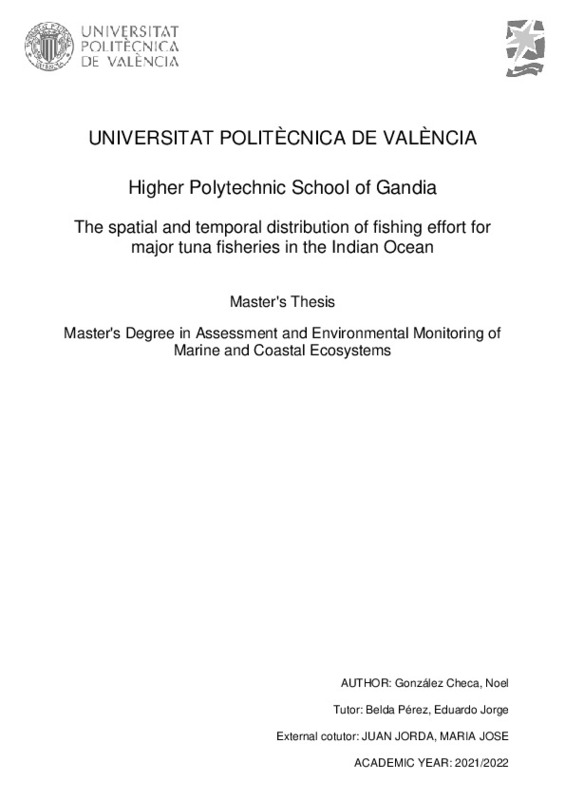|
Resumen:
|
[ES] Las pesquerías de atún se encuentran entre las pesquerías más importantes y valiosas del mundo. Estas pesquerías interactúan con muchas especies no objetivo, muchas de ellas consideradas taxones vulnerables y especies ...[+]
[ES] Las pesquerías de atún se encuentran entre las pesquerías más importantes y valiosas del mundo. Estas pesquerías interactúan con muchas especies no objetivo, muchas de ellas consideradas taxones vulnerables y especies amenazadas, incluidos tiburones, rayas, tortugas marinas, aves marinas y mamíferos marinos. Muchos de estos taxones vulnerables y amenazados permanecen sin evaluar, ya que las instituciones pesqueras enfrentan la dificultad de utilizar los métodos cuantitativos tradicionales, hambrientos de datos, para evaluar estas especies con pocos datos. La herramienta EASI-Fish (Evaluación ecológica de los impactos sostenibles de las pesquerías) desarrollada recientemente permite realizar evaluaciones cuantitativas de especies con pocos datos. Este nuevo método tiene la ventaja de calcular los impactos acumulativos de múltiples pesquerías y producir estimaciones de puntos de referencia de pesquerías convencionales (puntos de referencia de mortalidad por pesca y biomasa) para evaluar el estado de vulnerabilidad de la población.
El trabajo se centrará en el desarrollo de la herramienta EASI-Fish para evaluar cuantitativamente el estado de taxones vulnerables y amenazados seleccionados capturados por las pesquerías de atún que operan en los océanos Atlántico e Índico. La evaluación EASI-Fish tiene como objetivo producir mapas predictivos de la distribución de especies, el esfuerzo de pesca y las parcelas de las fases de vulnerabilidad, determinando conjuntamente el estado de las especies vulnerables en función de los puntos de referencia biológicos estimados.
La aplicación de la herramienta EASI-Fish requiere la preparación y estimación por adelantado de varias capas de datos de información. Estos incluyen: 1) desarrollo de modelos de hábitat para inferir la distribución espacial de especies, 2) cálculo de la superposición volumétrica de cada pesquería con la distribución de especies, y 3) compilación de información clave sobre el ciclo de vida de las especies (crecimiento, edad y longitud en madurez, edad máxima, peso por talla, mortalidad natural) para informar los modelos de rendimiento por recluta y la estimación de los puntos de referencia biológicos.
Específicamente, se desarrollarán mapas de esfuerzo de pesca en cuadrículas espaciales para los principales artes de pesca en el Océano Índico, que se utilizarán para estimar la superposición volumétrica de cada pesquería con la distribución de cada especie vulnerable evaluada.
El Alumno de Máster se encargará de las siguientes tareas:
(1) Describir los principales artes de pesca que operan en el Océano Índico dirigidos al atún y especies afines bajo el ámbito de la Comisión del Atún del Océano Índico.
(2) Recopilar de la página web de la IOTC los conjuntos de datos disponibles públicamente con el esfuerzo de pesca para las pesquerías de la IOTC y describir cómo se mide el esfuerzo de pesca para cada tipo de arte.
(3) Preparar los conjuntos de datos del esfuerzo pesquero para analizar la evolución espacial y temporal del esfuerzo pesquero para las principales pesquerías que operan en el Océano Índico.
(4) Describir la evolución espacial y temporal de los principales artes de pesca.
(5) Describir la principal limitación de los datos y las lagunas de datos.
[-]
[EN] Tuna fisheries are among the largest and most valuable fisheries in the world. These fisheries interact with many non-target species, many of them considered vulnerable taxa and threatened species, including sharks, ...[+]
[EN] Tuna fisheries are among the largest and most valuable fisheries in the world. These fisheries interact with many non-target species, many of them considered vulnerable taxa and threatened species, including sharks, rays, sea turtles, seabirds and marine mammals. Many of these vulnerable and threatened taxa remain unassessed as fisheries institutions face the difficulty of using the traditional data-hungry quantitative methods to assess these data-poor species. The recently developed EASI-Fish tool (Ecological Assessment of the Sustainable Impacts of Fisheries) allows for the quantitative assessments of data-poor species. This new method has the advantage of calculating the cumulative impacts of multiple fisheries and producing estimates of conventional fisheries reference points (fishing mortality and biomass reference points) to assess population vulnerability status.
This study will assist in the development of the EASI-Fish tool to quantitatively assess the status of selected vulnerable and threatened taxa caught by tuna fisheries operating in the Atlantic and Indian Oceans. The EASI-Fish assessment aims to produce predictive maps of species distributions, fishing effort and vulnerability phase plots, together determining the status of vulnerable species based on the estimated biological reference points.
The application of the EASI-Fish tool requires the preparation and estimation in advance of several data layers of information. These include: 1) development of habitat models to infer the spatial distribution of species, 2) calculation of the volumetric overlap of each fishery with the species distribution, and 3) compilation of key life history information of species (growth, age and length at maturity, maximum age, weight at length, natural mortality) to inform yield per recruit models and the estimation for the biological reference points.
Specifically, the Master Student will assist in the development of the spatially gridded fishing effort maps for major fishing gears in the Indian Ocean, which will be used to estimate the volumetric overlap of each fishery with distribution of each vulnerable species assessed.
The Master Student will be in charge of the following tasks:
(1) Describe the major fishing gears operating in the Indian Ocean targeting tuna and tuna-like species under the purview of the Indian Ocean Tuna Commission
(2) Compile from the IOTC webpage the publicly available data sets with fishing effort for IOTC fisheries and describe how fishing effort is measured for each gear type
(3) Prepare the fishing effort datasets for analyzing the spatial and temporal evolution of fishing effort for major fisheries operating in the Indian Ocean
(4) Describe the spatial and temporal evolution of major fishing gears
(5) Describe the major limitation of the data and data gaps
[-]
|







